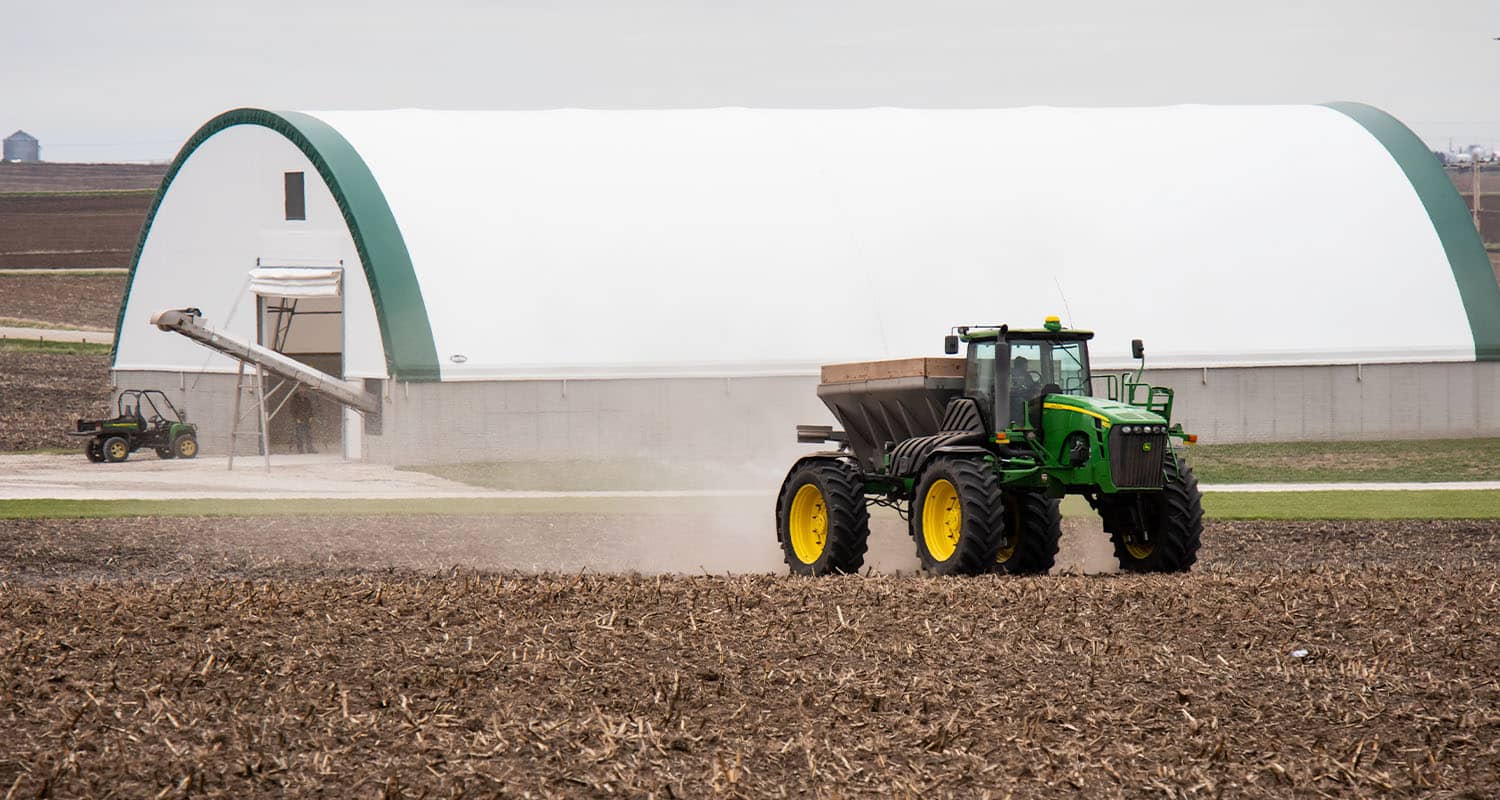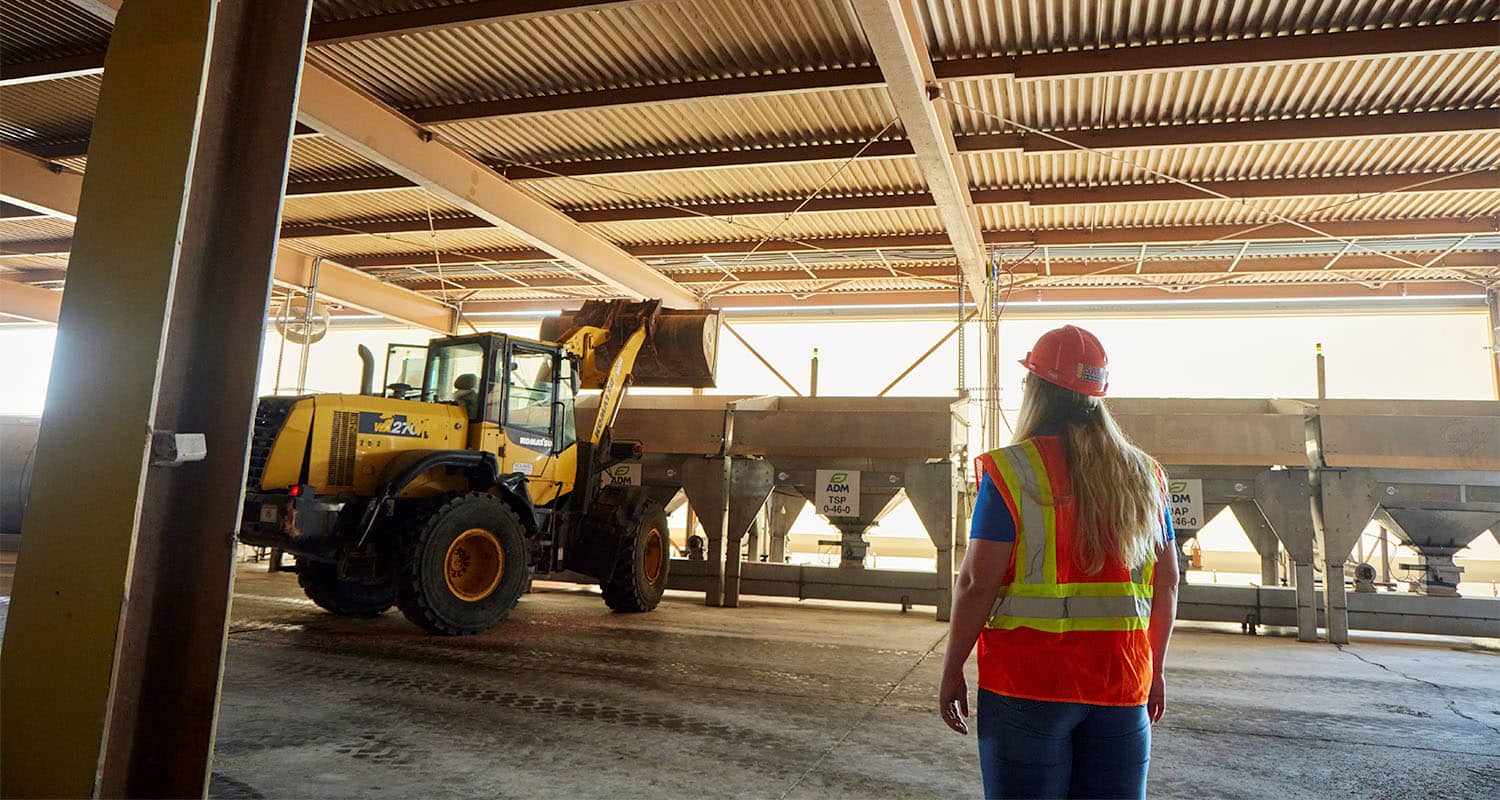Top 5 Crop-Input Purchase Strategies and 2024 Fertilizer Outlook
No matter the year, crop-input cost decisions will play a huge role in determining your profit outcomes. To help you succeed in your plans for next year’s crop, consider our top 5 input-purchase strategies:
#1 Pair Grain Sales with Fertilizer Purchases
Plan to formulate a crop marketing strategy that pairs grain sales with your costliest input purchases. Fertilizer is typically the largest crop-production cost, generally representing as much as one-third the total input cost to produce corn and soybeans. To achieve favorable profit margins, know your breakeven production cost for each crop, and lock in grain sales with your fertilizer purchases. This will set the bar for crop-input affordability and grain-sale profit margins.

Fertilizer and grain prices are often volatile, but you can collaborate with ADM grain and fertilizer representatives to help you plan or visit the ADM Fertilizer customer portal to learn more about fertilizer purchase opportunities. You can purchase fertilizer on this web portal or the ADM Fertilizer app (available from the App Store or Google Play), with fertilizer delivery available as soon as seven days out or up to 12 months away. You can also lock in your price without having to take ownership until you need it.
#2 Consider Input Purchases to Optimize Farm Productivity and Sustainability
Maximize your crop nutrition program with a crop input purchase plan that optimizes both your farm’s productivity and sustainability. ADM offers a full line of traditional nutrients, plus polymer coat and biostimulant products that increase nitrogen use efficiency. Our products, programs and representatives will help you leave a lasting, sustainable legacy and add significantly to your bottom line. As an example, our re:generations program offers both financial and technical support to producers who newly adopt or continue current regenerative ag practices. The program rewards participants for practices that improve water quality, soil health, and biodiversity, and that reduce greenhouse gas emissions, among other possible natural resource benefits. Check the website soon for 2024 pre-enrollment dates as the 2023 enrollment has closed.
#3 Consider Purchase Opportunities that Optimize Logistics
Plan now to ensure you’ll have all necessary crop inputs easily accessible to you, exactly when you need them. Securing needs in advance, up to 12 months, is a great way to capture lows in the market, without having to take ownership of the product. Purchases can be set up as free on board (fob) or delivered, for the month that they’ll be needed. Blending products, depending on the facilities location, can also be provided to match the needs of the farm. Adding storage is another opportunity to increase efficiency, avoid logistic bottlenecks, and negate any delays or unforeseen circumstances.
Contact your ADM fertilizer representative today to handle your crop input transportation needs.

#4 Pick the Most Economical Product
Be ready to purchase fertilizer products that enable you to capture low prices. For example, urea nitrogen (N) prices tend to have greater volatility throughout the year than either anhydrous or UAN. For phosphorous (P) fertilizers, Map, in comparison to other phosphate products has historically been the most economical choice, relative to per pound of phosphate. However, recent shifts in the global production and trade network among phosphate products have brought about larger price spreads that now provide opportunities to procure other phosphates at a better value than MAP. To better understand when favorable buying windows are open, consider working with your ADM fertilizer representative.

In addition to choosing the right fertilizer nutrient at the right price, ADM representatives can help you optimize your overall crop nutrition program. Whether you’re considering N, P, potassium, sulfur, micronutrients or biostimulants, visit the ADM Crop Nutrition and Health webpage or contact a representative to learn more.
#5 Finance Solutions: Selecting the Best Option for Your Farm
When purchasing crop inputs, ensure that you have a solution to help manage interest rates while optimizing cash flow. Consider ADM and its farm credit partnerships while examining the many competitive financing options. These offerings will help you find the best financing option for your farm, whether it’s with variable or fixed interest rates.
Additionally, working with your ADM grain account managers can help you optimize your grain sales to provide the cash flow you’ll need, when it’s needed.
2024 Crop Fertilizer Outlook
Farmers should have several opportunities to lock in lower 2024 crop fertilizer prices as they fluctuate throughout the year, depending on nutrient product forms. See below for ADM Fertilizer’s current outlook on pricing of macronutrients and sign up at the ADM Fertilizer Portal to receive frequent market updates to help you make more informed buying decisions.
Nitrogen-Urea:
Recommendation: Based on forecasted upside risk and downside potential, buying urea earlier rather than later will likely work best.
Market Highlights: Fundamentally expect values to range from $300-$320 New Orleans, Louisiana (NOLA) for December as liquidity comes forward for pre-pay. Q1 price guidance is subject to key upside and downside fluctuations, but market bias to the downside appears to outweigh upward price potential during this time. Given current crop commodity values, with urea as the cheapest N form, and the NOLA market trading at a discount to many other international (albeit liquid) markets today, farmers delaying purchasing to “short” the market probably doesn’t make sense, especially given their mandate to create farm production margin, not trade urea.
The potential urea upsides are many and varied. They include: European energy prices that could threaten further ammonia plant shutdowns; strong farm-gate economics at current price levels relative to crop commodities; quickly changing geopolitical assumptions; and potential pent-up European market demand, which needs to be positioned by March.
The potential urea downsides are also many and varied. They include: lower demand from Brazil even with safrinha corn crop acreage likely reduced due to poor weather, and a large influx of index cargos that have balanced sales and demand (S&D); and lower import demand from India due to increased domestic production.
Nitrogen-UAN:
Recommendation: Buy 25-35% of needs over the next few months while selling December Corn to decrease risk and lock in some margin, with a potential slight price reset in late January/February being another buying opportunity.
Market Highlights: UAN (28% & 32%) has stayed flat to firm since August, with low inventory stocks throughout the Midwest at both production facilities and terminals. We expect UAN to continue to carry a premium to urea in the short term.
Phosphate:
Recommendation: Layer in 25-50% of spring needs while selling some grain against this to lock in margin during this winter fill period.
Market Highlights: Winter fill programs have rolled out recently while global phosphate prices have continued to firm through the normal Q4 reset period. India and China remain the key factors in determining price direction moving forward. China has put substantial limitations the availability of phosphate exports, while India’s Nutrient Base Subsidy (NBS) program has left Indian importers largely out of the global market for most of Q4.
Potash:
Recommendation: Buy a layer for spring needs with any forward grain sales. Expect flat to potentially lower prices during the winter fill period.
Market Highlights: A bullish hangover from 2022 has finally sagged enough to find a floor and reengage buyers enough to begin to buy back demand. Producers catching up on application rates and a strong North American application season ensures the system ends 2023 empty and facilitates continued demand.
Given the concentrated nature of potash producers, geopolitical risks remain to supply availability. While Russia and Belarus continue to supply more than market observers anticipated following the Ukraine invasion, they are still forecasted to remain below their 2021 export volumes. Israel, as the world’s fourth largest potash exporter, with 8% of global exports, is the latest supplier to potentially be affected by conflict-related supply disruptions. Their main export port of Ashdod, while close to the conflict zone, remains in normal operation, but the longer the conflict continues, the greater the disruption risk.
Bullish indicators include geopolitical risks; increased affordability that boosts demand; general widespread market acceptance of current values; and concern around securing supply with continued ongoing conflicts.
Bearish indicators include bearish grain prices that begin to erode affordability and demand; a global economic slowdown; more than anticipated global supplies; and a strong North American fall season that leads to lower spring needs.
AMS (Ammonium Sulfate):
Recommendation: Remain neutral or consider buying a layer for spring.
Market Highlights: Given that ammonium sulfate is primarily a spring-use product, the market can get extremely quiet in the offseason. However, a few things are going on behind the scenes, which will impact pricing and availability moving into 2024. About 75% of the U.S.-produced AMS is a byproduct from nylon production, so when demand for nylon products diminishes during a slower economy, there is less available AMS for sale. The other 25% of U.S. production is tied to sulfuric acid/ammonia inputs, and at current product price levels, a large percentage of production is idled due to negative margins. Every month we move forward with reduced production equates to a tighter S&D and a scenario that product availability throughout the Corn Belt this spring could be limited.
The current and forward pricing levels that ADM is offering is competitive with the cheaper urea values and worth considering. If reduced supply persists, any downside pricing risks are likely limited, and running short of available product (resulting in higher prices into spring) is plausible. To follow our monthly input on the fertilizer S&D fluctuations, join our next Farm Direct Fertilizer Report call on January 10. Visit the website to learn more.
ADM is providing this communication for informational purposes, and it is not a solicitation or offer to purchase or sell commodities. The sources for the information in this communication are believed to be reliable, but ADM does not warrant the accuracy of the information. The information in this communication is subject to change without notice. If applicable, any information and/or recommendations in this communication do not take into account any particular individual’s or company’s objectives or needs, which should be considered before engaging in any commodity transactions based on these recommendations. ADM or its affiliates may hold or take positions for their own accounts that are different from the positions recommended in this communication.
